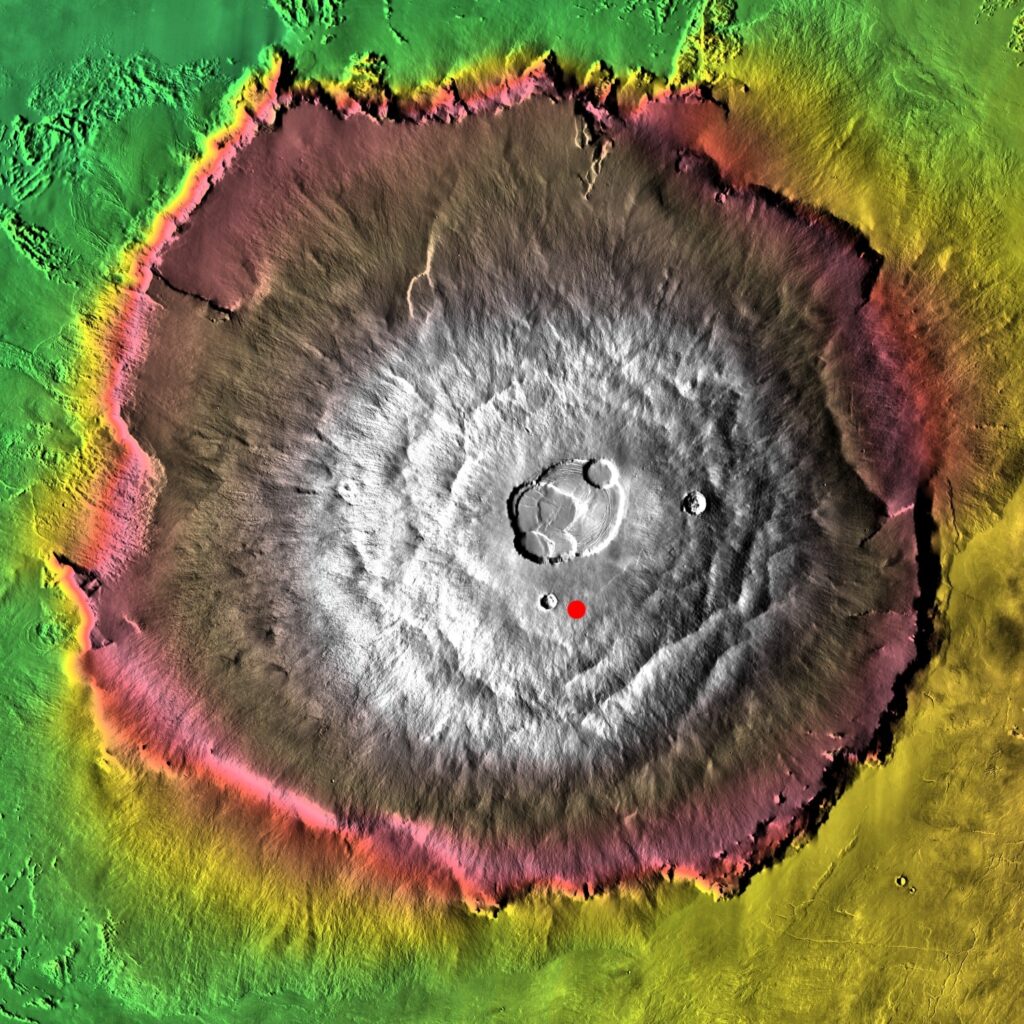Between climate change, viral contagion, and military conflict, the past few years have presented unending complexity for businesses spanning the globe. But can you imagine how much greater the challenge when humans someday settle worlds beyond our own and organizations race to meet demand for interplanetary commerce and logistics? Supply chain professionals, of course, have yet to set foot on Mars. But what if I told you our celestial neighbor, despite lacking container ships or semitrailer fleets, nonetheless offers an extraordinary object lesson in supply chain management for business leaders here on Earth?
At first glance, the photograph above seems unremarkable. Captured by the Mars Reconnaissance Orbiter back in May, the image displays the craters and gullies common to the Red Planet – similar to those on the Earth’s moon. Yet what we see is no ordinary stretch of Martian dirt. It’s the peak of Olympus Mons, the tallest volcano on Mars. In fact, it’s the highest elevation in our solar system, towering over the surface at more than twice the size of Everest.
But it looks nothing like a mountain. Or a volcano.
Why not?
The answer emerges with perspective.
The image at top represents a narrow, horizontal sliver of a much larger field as viewed from a height of 257 kilometers, or 22 times the altitude of a typical commercial aircraft here on Earth. Still, everywhere within the larger field looks just like the smaller one! There’s no hint of a volcano anywhere in sight. But by increasing altitude even farther, visibility extends outward – until, eventually, the familiar caldera structure comes into sharp relief. The deceptively flat landscape glimpsed this spring by the Mars Reconnaissance Orbiter fits inside the red dot shown below:

For scale, Olympus Mons roughly approximates the area of Poland. Because the volcano is so immense, the slope along most of the surface is extremely modest and, in many places, imperceptible.
Aided by cloud-based technologies, many businesses on Earth – not unlike the Mars Reconnaissance Orbiter – possess acute powers of visibility. But how far outward does that visibility extend? Can a business see with precision only inside its own four walls, or can it see beyond them as well? Can it peer into the interconnected operations of its nearest trading partners? What about those of its trading partners’ trading partners? And so on?
Visibility, in business-to-business commerce and astronomy alike, requires not only depth but breadth. If the field of view falls under too narrow a lens – isolated, for example, from vital yet distant trading partners – then perception, even when detailed, may be narrow rather than holistic. Absent perspective, the highest point in our solar system can easily be mistaken for undifferentiated terrain pockmarked by undistinguished craters.
Whether in supply chain management or aeronautic science, visibility and resilience are mutually reinforcing. By shielding the Mars Reconnaissance Orbiter from solar flares, frigid temperatures, and cosmic debris, thermal blankets have extended the spacecraft’s lifespan from an expected five years to 17 and counting. Meanwhile, the Orbiter’s ongoing telemetry reporting equips engineers back on Earth with the data they need to design even more resilient spacecrafts in the future. They also learn from setbacks such as when, in 2018, a planet-wide dust storm brought the 14-year mission of the Mars Opportunity rover to a sudden, silent standstill.
Disruption, of course, wreaks an equal measure of havoc on supply chains and logistics. To instill resilience across increasingly integrated business processes, organizations and their trading partners turn not to the heavens but to the cloud – where digital applications harness vast repositories of operational data to manage dispersed assets, deepen mutual visibility, foster multi-tier collaboration, mitigate supply chain risk, and extend competitive advantage. When business leaders draw inspiration from planetary exploration in marshaling the full depth and breadth of the data available to them for analysis and decision-making, the visibility and resilience that follow are as limitless as space itself. Though connected commerce, cloud-based networks send growth and innovation rocketing skyward.
Andreas Heckmann is executive vice president of Product Engineering and head of Customer Solution Support & Innovation at SAP.
Top photo: NASA/Jet Propulsion Laboratory Caltech/University of Arizona. Scale: 1 cm = 185 m.



